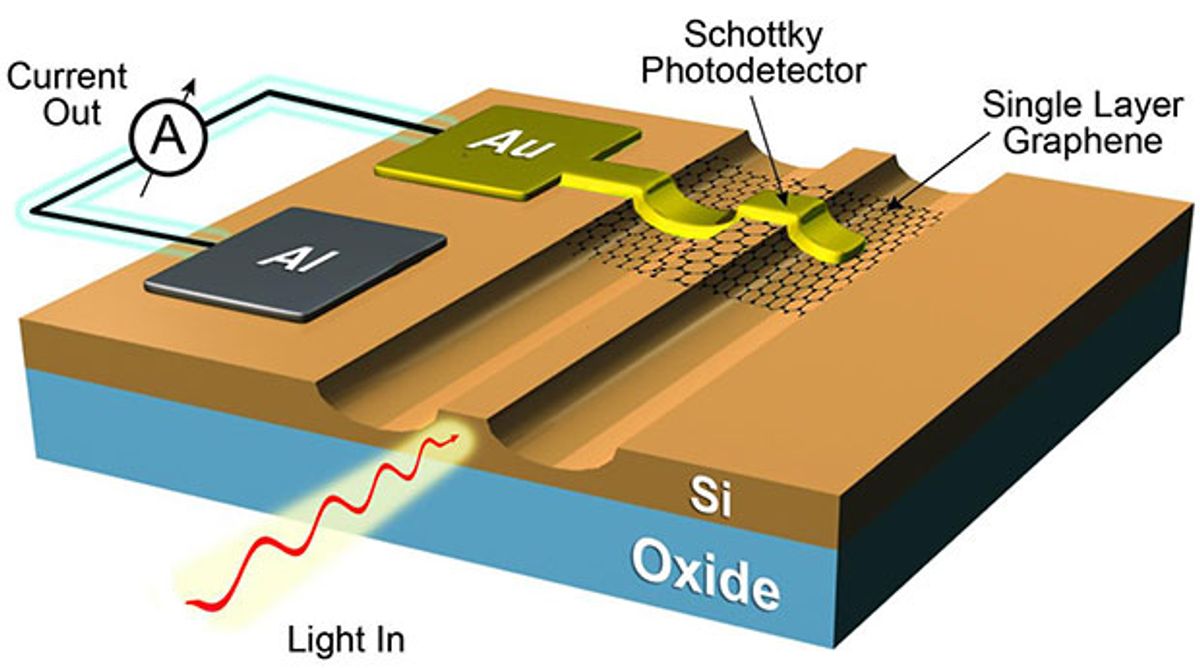While graphene has faced challenges in the field of digital logic because of its lack of an inherent band gap, it has been that very weakness that has attracted many researchers to exploring its use in optoelectronics. This lack of a band gap makes graphene an extreme broadband absorber, enabling photodetection for visible, infrared, and terahertz frequencies.
Now, in research supported by the European Commission’s €1 billion ($1.3 billion) 10-year project, the Graphene Flagship, a group of universities—including the University of Cambridge in the UK, The Hebrew University in Israel, and John Hopkins University in the United States—has successfully combined graphene with silicon on a chip to make “high-responsivity” Schottky barrier photodetectors.
Such photodetectors are formed by a junction between metal and a semiconductor. Since photodetectors are a key building block of optoelectronic links, the result of this research could lead to far less energy being consumed to process and move information, a key achievement in realizing the potential of the Internet of Things (IoT), say the researchers.
In research described in the journal Nano Letters, these graphene-based photodetectors achieve a responsivity of 0.37 ampere of current per Watt of incident light on the photodiode using 1.55 micrometer light. This high responsivity is comparable to that of the silicon germanium detectors currently used in silicon photonics.
While silicon-based photodetectors can do the job for detecting visible light, they fall short when it comes to detecting near-infrared radiation (NIR). The reason for this is that the energy of NIR photons at telecom wavelengths is not strong enough to bridge the band gap of silicon. For this reason, photodetectors have been fashioned out of a combination of silicon and germanium, which requires a complex and comparatively expensive fabrication process. This new graphene-silicon combination could be far simpler and cheaper to produce.
“This is a significant result which proves that graphene can compete with the current state of the art by producing devices that can be made more simply, cheaply and work at different wavelengths,” said Andrea Ferrari, a professor at the University of Cambridge’s Graphene Center, in a press release. “Thus paving the way for graphene integrated silicon photonics.”
As far as achieving the aim of consuming less energy, Ferrari sees this most recent work as a significant achievement. “Graphene can beat current silicon photonic technology in terms of energy consumption,” he said.
Regarding optical communications for IoT: “This is a first step towards this, and, over the next two years the aim of the wafer-scale integration and optoelectronics work-packages of the Flagship is to really make this happen,” the University of Cambridge’s Ilya Goykhman said in a press release.
Over the next two years, this line of research will branch out from the photodetector that they have produced here to optical modulators.
Ferrari added: “We have shown the potential for the detector but we also need to produce a graphene-based modulator to have a full, low energy optical telecommunication system, and the Flagship is working hard on this problem.”
Dexter Johnson is a contributing editor at IEEE Spectrum, with a focus on nanotechnology.



